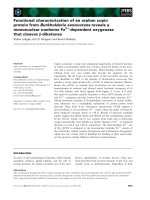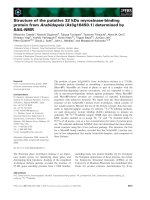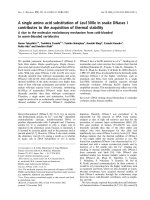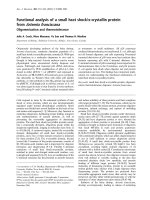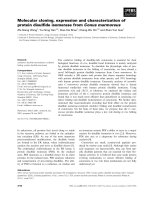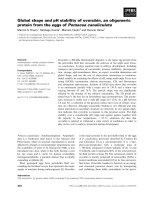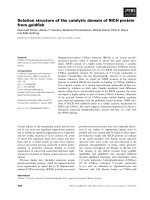acquisition of protein from lima bean phaseolus lunatus with high recovery efficiency
Bạn đang xem bản rút gọn của tài liệu. Xem và tải ngay bản đầy đủ của tài liệu tại đây (8.58 MB, 99 trang )
<span class="text_page_counter">Trang 1</span><div class="page_container" data-page="1">
MINISTRY OF EDUCATION AND TRAINING
<b>HO CHI MINH CITY UNIVERSITY OF TECHNOLOGY AND EDUCATION FACULTY FOR HIGH QUALITY TRAINING </b>
<b> </b>
<b>ACQUISITION OF PROTEIN FROM LIMA BEAN (PHASEOLUS LUNATUS) WITH HIGH RECOVERY</b>
<b> EFFICIENCY </b>
<b>GRADUATION PROJECT </b><b>CHEMICAL AND FOOD TECHNOLOGY</b>
<b>LECTURER: PhD. PHAM THI HOAN</b>
<b>STUDENT: LE DUC HUY HOANG TRAN HUY</b>
<small>S K L 0 1 2 5 2 7 </small>
<b>Ho Chi Minh City, January 2024</b>
</div><span class="text_page_counter">Trang 2</span><div class="page_container" data-page="2"><b>HCMC UNIVERSITY OF TECHNOLOGY AND EDUCATION FACULTY OF CHEMICAL AND FOOD TECHNOLOGY </b>
<b>FOOD TECHNOLOGY </b>
<b>GRADUATION THESIS </b>
<b>CODE: 2023-19116041 </b>
<b>HO CHI MINH CITY – 01/2024 </b>
<b>ACQUISITION OF PROTEIN FROM LIMA BEAN </b>
<i><b>(PHASEOLUS LUNATUS) WITH HIGH RECOVERY </b></i>
<b>EFFICIENCY </b>
<b> INSTRUCTOR: PhD. PHAM THI HOAN STUDENTS: LE DUC HUY HOANG 19116041 </b>
<b>TRAN HUY 19116034 </b>
</div><span class="text_page_counter">Trang 3</span><div class="page_container" data-page="3">
THE SOCIALIST REPUBLIC OF VIETNAM
<b>Independence – Freedom– Happiness </b>
---
<b>GRADUATION THESIS ASSIGNMENT </b>
1. <i><b>Thesis title: Acquisition of protein from Lima bean (Phaseolus lunatus) with high </b></i>
recovery efficiency.
2. <b>Thesis assignment: </b>
- Synthesize scientific documents and articles, combine and experiment to select an appropriate technological process in acquisition of protein from Lima bean with high recovery efficiency.
- Conduct surveys and evaluate some product properties such as chemical compositions, structure and molecular weight of proteins obtained from Lima protein.
- Proposing directions for applying protein from Lima bean in the field of food technology.
The content and requirements of the graduation thesis have been approved by the Chair of the Food Technology program
<b>CHAIR OF THE PROGRAM </b>
<i> (Sign with full name) </i>
</div><span class="text_page_counter">Trang 4</span><div class="page_container" data-page="4">i
<b>ACKNOWLEDGEMENTS </b>
First of all, allow us to express our most respection to all the teachers are working at Ho Chi Minh City University of Technology and Education in general, and to all the Asscociate Professors, Doctors of Philosophy and Masters at the Faculty of Chemical and Food Technology in particular. Throughout the process of learning and growing up at university, undergo a thorough and complete training program, along with the enthusiastic teaching and support of teachers, we have been equipped with knowledge from basic to advanced, from general to academic in the field we are pursuiting. The studies acquired from the university environment along with the practical sharing from the experiences of the teachers will certainly be valuable tools on the upcoming working path in larger and realistic atmospheres.
Most especially, we would like to express our deep appreciation to Doctor. Pham Thi Hoan, a lecturer working at the Faculty of Chemical and Food Technology, who has accepted and instructed us to complete this graduation thesis. In addition to provide support and direction for the thesis, we also received a lot of support from the instructor in terms of chemicals, machines and equipments needed to complete the experiments.
Besides, we would also like to send an appreciation to Mrs. Ho Thi Thu Trang - faculty laboratory manager. Respect to her dedicated help with tools, laboratory rooms and instructions for operating of various equipments, we were able to complete our graduation thesis.
Finally, we would like to show our love to fellow classmates, who worked on the graduation thesis together, along with family and friends, for their support and encouragement throughout the thesis process in the laboratory.
Due to our lack of experiences, knowledge, and also limited time, there might be some mistakes during processing the thesis. We are looking forward to be forgiven and always get ready to hear your contributions to assist us in improving our topic.
Finally, we would like to send our best wishes to the Faculty of Chemical and Food Technology. Wishing health and success to everyone.
Sincerely thank, Le Duc Huy Hoang and Tran Huy.
</div><span class="text_page_counter">Trang 5</span><div class="page_container" data-page="5">ii
<b>DECLARATION </b>
We declare that the Graduation Thesis “Acquisition of protein from Lima bean
<i>(Phaseolus lunatus) with high recovery efficiency” is the result of our study and has never </i>
been published in other studies before. We took research ethics seriously during the implementation process of the thesis.
All the results of this project are the result of our researches and experiences, and all references in this project are properly referenced in accordance with rules.
We are solely responsible for the accuracy of the numbers, statistics, and other aspects of our graduation thesis.
<i><b> Ho Chi Minh city, January ... ,2024 </b></i>
<i> (Sign with full name) </i>
</div><span class="text_page_counter">Trang 17</span><div class="page_container" data-page="17">
vi
<b>TABLE OF CONTENTS </b>
ACKNOWLEDGEMENTS ... i
DECLARATION ... ii
ASSESSMENT FORM GRADUATION THESIS OF FOOD TECHNOLOGY ... iii
(FOR SUPERVISOR) ... iii
ASSESSMENT FORM GRADUATION THESIS OF FOOD TECHNOLOGY ... iv
(FOR REVIEWER) ... iv
ASSESSMENT FORM GRADUATION THESIS OF FOOD TECHNOLOGY ... v
(FOR COMMITTEE MEMBERS) ... v
1.4.2. Scope of the research ... 3
1.5. Scientific and practical significance ... 3
1.5.1. Scientific significance ... 3
1.5.2. Practical significance ... 3
CHAPTER 2. LITERATURE REVIEW ... 4
2.1. Overview of material ... 4
</div><span class="text_page_counter">Trang 18</span><div class="page_container" data-page="18">vii
2.1.1. Introduction to legume ... 4
2.1.2. Introduction to Lima bean ... 5
2.1.3. Classification of Lima bean ... 7
2.1.4. Nutritions of Lima bean ... 10
2.2 Overview of protein ... 13
2.2.1. Introduction to protein ... 13
2.2.2. Introduction to legume protein ... 14
2.2.3. Introduction to Lima protein ... 15
2.3. Recovery methods of protein ... 17
2.3.1. Salting out ... 18
2.3.2. Isoelectric point precipitation ... 18
2.3.3. Organic solvent cause precipitation ... 19
2.4. Research situations of the topics ... 19
2.4.1. Domestic situation ... 19
2.4.2. Overseas situation ... 20
CHAPTER 3. MATERIALS AND METHODS ... 22
3.1. Materials, chemicals, devices and equipments ... 22
3.1.1. Materials ... 22
3.1.2. Chemicals ... 22
3.1.3. Equipment and Devices ... 23
3.2. Research framework and protein collection process ... 23
</div><span class="text_page_counter">Trang 19</span><div class="page_container" data-page="19">viii
3.4. Analytical methods ... 33
3.4.1. Determine the extraction yield of protein ... 33
3.4.2. Determine the protein recovery yield of protein ... 33
3.4.3. Determine the physicochemical properties of protein ... 33
3.4.4. Determine the functional properties of protein ... 34
3.4.5. Analytic methods ... 38
CHAPTER 4. RESULTS AND DISCUSSIONS ... 39
4.1. Determine the appropriate extraction regime ... 39
4.2. Determine the physicochemical properties of protein ... 43
4.2.1. Determination of chemical compositions of Lima powder and Lima protein .... 43
4.2.2. Determination of secondary structure of protein (FTIR) ... 45
4.2.3. Determination of molecular weight of protein (SDS-PAGE) ... 46
4.3. Determine the functional properties of protein ... 49
4.3.1. Determine the water/oil absorption capacity (WAC - OAC) ... 49
4.3.2. Determine the foam capacity and stability (FC – FS) ... 50
4.3.2. Determine the emulsifying activity index and stability (EAI – ESI) ... 52
4.3.4. Determine the solubility ... 54
CHAPTER 5. CONCLUSIONS AND RECOMMENDATIONS ... 57
5.1. Conclusions ... 57
5.2. Recommendations ... 58
REFERENCES ... 59
APPENDIX ... 68
</div><span class="text_page_counter">Trang 20</span><div class="page_container" data-page="20">ix
<b>LIST OF FIGURES </b>
<i>Figure 2. 1. Production of grain legumes in the 12 European countries where the total harvest exceeded 100,000 t in 2013. Data from Eurostat (2016) (faba bean, pea, soybean, lupins) and FAOSTAT (2016) (lentil, chickpea, common bean). ... 5</i>
<i>Figure 2. 2. Lima plants ... 6</i>
<i>Figure 2. 3. Lima beans ... 7</i>
<i>Figure 2. 4. Baby Lima beans ... 9</i>
<i>Figure 2. 5. Fordhook Lima beans ... 9</i>
<i>Figure 2. 6. Speckled Lima bean ... 9</i>
<i>Figure 3. 1. Lima beans ... 22</i>
<i>Figure 3. 2. Research framework ... 24</i>
<i>Figure 3. 3. Diagram of protein collection ... 26</i>
<i>Figure 3. 4. Scheme of experimental design 1 ... 31</i>
<i>Figure 3. 5. Scheme of experimental design 2 ... 33</i>
<i>Figure 4. 1. Complete research diagram of protein collection ... 43</i>
<i>Figure 4. 2. Results of FTIR from Lima protein (PCS10) and Soy protein (SPI) ... 45</i>
<i>Figure 4. 3. Results of SDS-PAGE from Lima and Soy protein sample ... 47</i>
<i>Figure 4. 4. Calibration curve between logarithm of molecular weight and travel distance of proteins ... 47</i>
<i>Figure 4. 5. Influence of pH of PCS10 suspension on foam capacity ... 51</i>
<i>Figure 4. 6. Influence of pH of SPI suspension on foam capacity ... 51</i>
<i>Figure 4. 7. Result of EAI of Lima protein (PCS10) and Soy protein (SPI) ... 53</i>
<i>Figure 4. 8. Result of ESI of Lima protein (PCS10) and Soy protein (SPI) ... 53</i>
<i>Figure 4. 9. Result of the solubility of Lima protein ... 55</i>
</div><span class="text_page_counter">Trang 21</span><div class="page_container" data-page="21">x
<b>LIST OF TABLES </b>
<i>Table 2. 1. Description of commercially available Lima bean varieties ... 7</i>
<i>Table 2. 2. Proximate composition of Lima bean samples (%) ... 10</i>
<i>Table 2. 3. The mineral content of the Lima bean samples (mg/100g) ... 11</i>
<i>Table 2. 4. The amounts of amino acids in Lima bean seeds ... 12</i>
<i>Table 4. 1. Results of experimental design 1 ... 39</i>
<i>Table 4. 2. Results of experimental design 2 ... 40</i>
<i>Table 4. 3. Chemical compositions of Lima powder and Lima protein ... 43</i>
<i>Table 4. 4. Results of WAC and OAC from proteins ... 49</i>
</div><span class="text_page_counter">Trang 22</span><div class="page_container" data-page="22">xi
<b>LIST OF ABBREVIATIONS </b>
SPI: Soy Protein Isolate
WHC: Water Holding Capacity OHC: Oil Holding Capacity FC: Foam Capacity
FS: Foam Stability
EAI: Emulsion Ability Index ESI: Emulsion Stability Index RPM: Round per minute
SDS-PAGE: Sodium dodecyl sulfate-polyacrylamide gel electrophoresis FTIR: Fourier-transform infrared spectroscopy
</div><span class="text_page_counter">Trang 23</span><div class="page_container" data-page="23">xii
<b>ABSTRACT </b>
Currently, the demand for using plant-based protein sources to partially or entirely
<i>replace animal protein in human daily meals is increasing. Lima bean (Phaseolus lunatus) is </i>
a rich source of plant-based protein and abundant in nutrients but their researches in protein are not fully exploited, especially in Viet Nam. This research was conducted to extract protein from Lima bean, determine physicochemical properties (chemical compositions, molecular weight and secondary structure of the protein), as well as the functional properties (oil absorption, water absorption, foaming ability, emulsification capacity and solubility) of the extracted protein. The research results showed that the protein acquisition process, using a combination of solvent precipitation and isoelectric point precipitation at pH 4.5, tempereture of 4°C, achieved recovery efficiency at 82.14% higher than that in the other samples. The collected sample includes the moisture, protein, fat, ash, and total carbohydrate content of 10.59%, 67.50%, 0.76%, 5.28%, and 12.50%, respectively. The molecular weight and secondary structure of Lima bean protein also reflected similarities with commercially available soy protein isolate (SPI) on the market. Lima bean protein exhibited water absorption capacity nearly similar to the control sample (soy protein isolate - SPI), with values of 3.04 g/g and 3.65 g/g, respectively. Foaming ability and foam stability were also similar to soy protein isolate, reaching the highest values at pH 2 and 10; emulsification capacity and emulsion stability were highest at pH 10 and lowest at pH 4; solubility of Lima bean protein was higher than SPI at pH levels outside the isoelectric point of the protein (pH 2, 6, 8, and 10) and reaching the highest value at pH 10.
The results of this study indicate that Lima bean protein can be applied in various manufacturing fields such as meat processing technology, ice cream production or bakery and confectionery production, etc. The effectiveness of Lima bean protein in specific applications will be further clarified in our research.
</div><span class="text_page_counter">Trang 24</span><div class="page_container" data-page="24">1
<b>CHAPTER 1. INTRODUCTION </b>
<b>1.1. Problem statement </b>The currently trend in human dietary habit involves the combination or partial replacement of plant-derived protein with animal-derived protein (Alves & Tavares 2019). This approach is gradually becoming popularity because there are some evidences can prove that a balanced diet incorporating both protein sources can contribute to lowering the risk of common human ailments, including cardiovascular disease, type 2 diabetes, and issues
<i>related to overweight and obesity (Ferrari et al., 2022). </i>
Throughout history and up to the present day, the nutritional contributions from plants have consistently held a significant role in the daily diets of human beings. Around the world, legumes play an important part in humanity diet. Legume is considered the second most important food source for humans in a variety of locations of the world, after cereals, which are an essential part of the human diet. Especially in developing countries , they serve as an affordable source of protein when animal protein is lacking. Similar to grains and oil seeds, legumes are a great source of protein (22.37-28.05%). Fiber, vitamins, minerals and complex carbohydrates can all be found plentiful in legumes, which play an important role in human
<i>diet, contribute to the health of body (Du et al., 2014). Moreover, the food industry makes </i>
extensive use of some species of legumes, such soybean and common beans, because of their numerous functional qualities (like viscosity, emulsion and gelling abilities or foaming),
<i>which provide texture and sensory qualities (David Betancur-Ancona et al., 2004). Legumes </i>
also have a high lysine level, which makes them ideal for intergrating with other foods. The nutrient-dense seeds have an important role in biodiversity, sustainable agriculture, food
<i>security, and minimizing environmental change (da Silva et al., 2009). </i>
<i>Lima bean (Phaseolus lunatus L) are a noteworthy member of the Legume family, </i>
<i>Fabaceae, a high protein content species range from 21-26% (M. Sandoval-Peraza et al., </i>
2020), also known as “butter bean” in some regions, are renowned for their nutritional value and versatility in culinary applications. The Lima bean seeds grow from specific areas will have distinct characteristics from others. Originating from South America, particularly the Andes region, Lima beans have become a globally recognized legume.
Nowadays, there are two popular types of protein: Protein Concentrate (PC) and Protein Isolate (PI) are available under powder form. The way of deriving them are from alkaline-
</div><span class="text_page_counter">Trang 25</span><div class="page_container" data-page="25">2
based protein extraction processes. PI is typically obtained through extraction in an alkaline environment followed by precipitation at the “isoelectric point”, while PC is acquired by extracting protein in an alkaline environment and subsequently precipitating it with
<i>“alcohol” (da Silva et al., 2009; Zhao et al., 2012). </i>
Moreover, plant-based protein sources offer valuable supplementation options for individuals whose following vegetarian or vegan diets. Simultaneously, they adapt to the essential protein requirements of gymers or fitness enthusiasts who often depend on whey.
For these reasons, there have been many studies around the world in testing different methods of recovering protein from plant sources, to meet the increasing needs of humans in using and consumiung recovery protein as a supplemental protein source. Currently in Vietnam, protein products on the market are mainly produced from soybeans because of the popular crop, however Lima beans are not widely known by the populations and have high commercial consumption, even though they are also a nutritious source of protein from plants.
Acknowledging that problem, our research teams have examined and experimented with many techniques across the worldwide on the legume family in order to implement and identify an appropriate procedure for Lima bean production, made with a high protein production recovery efficiency from Lima bean.
<b>1.2. Research objective </b>
The research objective of the thesis is to research, combine and totally complete the technological process, obtain protein products with high recovery efficiency. Besides that, evaluate the physicochemical properties, functional properties of proteins from Lima bean seeds. From there, propose product application ranges of Lima bean proteins in the food technology field.
<b>1.3. Topic contents </b>
<i>The topic of “Acquisition of protein from Lima bean (Phaseolus lunatus) with high </i>
recovery efficiency” includes the following contents:
</div><span class="text_page_counter">Trang 26</span><div class="page_container" data-page="26">3
Synthesize scientific documents and articles, combine and experiment to select an appropriate technological process in producing protein from Lima bean with high collectiom efficiency.
Conduct surveys and evaluate some product properties such as chemical compositions, structure and molecular weight of proteins obtained from Lima bean.
Proposing directions for applying protein from Lima bean in the field of food technology.
<b>1.4. Research object and Scope of research 1.4.1. Research object </b>
<i>Lima bean (Phaseolus lunatus) are provided by the Thu Duc Wholesale Agricultural </i>
Market (141 National Highway 1A, Tam Binh Ward, Thu Duc City, Vietnam).
<i>Protein from Lima bean (Phaseolus lunatus) </i>
<b>1.4.2. Scope of the research </b>
The research was conducted at the laboratory of the Food Technology, Department of Chemical and Food Technology, Ho Chi Minh City University of Technical Education (HCMUTE).
<b>1.5. Scientific and practical significance 1.5.1. Scientific significance </b>
The outcomes of the research contribute to enhancing the process of obtaining protein and offer technological parameters for conducting experimental researches on Lima bean protein production adapted to local conditions.
The procedure for extracting protein from Lima bean can serve as a reference for research and academic studies at universities.
<b>1.5.2. Practical significance </b>
The processing methodology for this product can be implemented either in scale or industrial-scale production, contributing to the expansion of protein product varieties available in the market.
pilot-The results of the physicochemical and functional characteristics of protein help to determine the suitability of this product for large-scale commercial applications within food processing.
</div><span class="text_page_counter">Trang 27</span><div class="page_container" data-page="27"><i>the two families were domesticated together (Wang et al., 2003). Moreover, legumes are </i>
significant feed crops in tropical and temperate cLimates.
Minerals that are necessary for consumption are provided by legumes (Grusak 2002). Furthermore, it has been suggested that the secondary metabolites that shield plants from pests and diseases may also shield humans from various types of cancer (Madar & Stark 2002) and may even help treat diabetes. Grain legume eating has a hypoglycemic impact in addition to lowering blood cholesterol. Trypsin inhibitors and allergens are examples of
<i>antinutritional elements that are secondary molecules (Skolnick et al., 2001). </i>
The family has historically been split into three subfamilies: Papilionoideae, which includes the grain legumes in addition to the significant forage legumes, and Caesalpinioideae, which has 28 tribes. The warm-season legumes (tribe Phaseoleae) are
<i>similarly closely linked (Lee et al., 2001), as are the cool-season legumes (tribes Fabeae, </i>
</div><span class="text_page_counter">Trang 28</span><div class="page_container" data-page="28">5
Cicereae, and Trifolieae), which are somewhat separated from the Genisteae and closely
<i>related and extremely similar at the genome level (Wojciechowski et al., 2004). The </i>
Fabaceae family of plants, along with several other lesser-known species, are essential to biological nitrogen fixation (BNF), which occurs in symbiosis and is tens of times more efficient than in free-living bacteria. The production of synthetic fertiliser began to fix more nitrogen than BNF only in the last quarter of the 20th century. As Columella in ancient Rome demonstrated, even though ancient farmers would not have known how legumes worked, they would have recognised the influence of the bean on the next harvest (Evans 1998).
<i><b>Figure 2. 1. Production of grain legumes in the 12 European countries where the total </b></i>
<i>harvest exceeded 100,000 t in 2013. Data from Eurostat (2016) (faba bean, pea, soybean, lupins) and FAOSTAT (2016) (lentil, chickpea, common bean).</i>
<b>2.1.2. Introduction to Lima bean </b>
Lima beans are native to Guatemala, Mexico, and Peru. It spread throughout the Americas after being domesticated, and the Spaniards brought it to the Pacific Islands and the Philippines. It then spread to South-East Asia, while the slave trade brought the Lima bean to Western and Central Africa. The Lima bean has now become widely naturalized throughout the tropics. It thrives in humid, subhumid, and semi-arid tropical regions, as well as warm temperate climes. In humid regions, Lima beans are frequently intercropped with
</div><span class="text_page_counter">Trang 29</span><div class="page_container" data-page="29"><i>blooms (Bosch et al., 2002). Other names for butter beans are sieva beans, double beans, </i>
Madagascar beans, and wax beans. Serrano-Serrano and colleagues (2012) diskovered that during the cultivation process, people in this region domesticated this plant and produced two types of seeds: Large-seeds (Lima) (in the West Andes) and Small-seeds (Sieva) (in
<i>Central America) (Serrano‐Serrano et al., 2012). The giant grain was domesticated circa </i>
2000 BC, while the little grain was domesticated in Mesoamerica around 800 AD (Motta‐
<i>Aldana et al., 2010). This species of bean has a high nutritious content and thrives and </i>
develops well in the cLimate of our nation. However, it only appears intermittently in recipes such as bean soup and stews, and there are few items created from beans in the globe, with canned or frozen beans being the most acceptable. That is why it is beneficial to do study in order to diskover and maximize its full potential.
<i><b>Figure 2. 2. Lima plants </b></i>
</div><span class="text_page_counter">Trang 30</span><div class="page_container" data-page="30">7
<i><b>Figure 2. 3. Lima beans </b></i>
<b>2.1.3. Classification of Lima bean </b>
Bean cultivars currently differ significantly in terms of the number of days from planting to harvest, size, and shell color. Bean varieties are then classified into three categories: Baby-seed Lima bean, Fordhok-seed Lima bean, and speckled Lima bean. The Baby seed group includes varieties such as Eastland and Parkers; the Fordhook seed group includes popular types such as Carolina Sieva, Jersey, and Bliss; and the speckled seed group includes
<i>varieties such as Christmas and Jackson Wonders (Glancey et al., 1997), (Bailey 1896). We </i>
use protein from the Christmas variety in our report.
<i><b>Table 2. 1. Description of commercially available Lima bean varieties </b></i>
<b>Variety Type </b>
<b>Maturity-days </b>
<b>to harvest </b>
<b>Downy mildew resisyan</b>
<b>ce </b>
Sacramento Valley, Milling
Its small size and tendency to set pods on the ends of raceme can reduce harvest recovery with pod-stripper combines.
<b>Eastland </b> Baby 82 A,B,C,D Several <sup>Closely related to M-15. Has a </sup>more upright plant
</div><span class="text_page_counter">Trang 31</span><div class="page_container" data-page="31">8
architecture, more conducive to harvest by pod-stripper combine.
<b>8-78 </b> Baby 85 A,B,C,D <sup>Ben Fish </sup>Seed Co.
Larger plant type.
Consistently good yielding variety.
<b>184-85 </b> Baby 86 A,B,C,D <sup>Ben Fish </sup>Seed Co.
Larger plant type that sets more pods in the top of the plant. A good yielding variety.
<b>Jakson </b>
<b>Wonder </b> <sup>Speckled </sup> <sup>85 </sup> <sup>None </sup> <sup>Several </sup>
Speckled bean type, with more heat resistance than others.
Sacramento Valley, Milling
New variety that has demonstrated good yield potential in trials.
Ferry-Morse
Has demonstrated good yield potential in later plantings in Delaware when conditions are cooler.
<b>F1072 </b> Fordhook 95 A,B,C Several
Standard green-seeded Fordhook.
Has outyielded F1072 in trials. Recommended for trial use.
</div><span class="text_page_counter">Trang 32</span><div class="page_container" data-page="32">9
<i><b>Figure 2. 4. Baby Lima beans </b></i>
<i><b>Figure 2. 5. Fordhook Lima beans </b></i>
<i><b>Figure 2. 6. Speckled Lima bean </b></i>
</div><span class="text_page_counter">Trang 33</span><div class="page_container" data-page="33">10
<b>2.1.4. Nutritions of Lima bean </b>
<b>Proximate composition of the Lima bean samples </b>
Table 1 shows the results of the proximate composition of the Lima bean samples. All of the Lima bean samples had low moisture content and fell within the acceptable range of 0 - 13.5% (James 2013). The moisture level of the samples ranges from 7.01% for roasted Lima beans to 8.05% for fermented Lima beans. The moisture content of a food is an indicator of its water activity; foods with high moisture content perish quickly owing to
<i>microbial activity (Onyeike et al., 1995). The protein content of Lima bean samples ranged </i>
from 19.79% in roasted Lima beans to 22.24% in raw Lima beans. The protein content of raw Lima beans was lowered by all processing techniques. Similar results on protein content
<i>reduction after processing such as cooking and roasting have been reported (Ndidi et al., </i>
2014). Low fat levels were seen in both the processed and raw Lima beans, with the raw beans having a fat content of 1.20% and the roasted beans having 1.05%. There have been reports that Lima beans are low in fat (Handbook 1986). The beans' low fat content is advantageous since it lowers the risk of heart attacks and raises blood cholesterol levels
<i>(Hession et al., 2009). Additionally, processing decreased the Lima beans' crude fibre </i>
content. Crude fibre content in the germinated sample was greatest (6.22%) across all processing procedures. The Lima bean seeds were dehulled after soaking, which is likely why roasting and fermentation were very low (p<0.05) in crude fibre. There have been reports that the bean's seed coat has more fibre than the cotyledon. The amount of ash in the samples of roasted and germinated Lima beans did not differ significantly (p>0.05). The least amount of ash was found in cooked Lima beans; this might be because salts and minerals leached into the cooking liquid. The Lima beans' carbohydrate content rose with each processing technique. High amount of carbohydrates, which breaks down the starch granules and softens the cellulose during processing, increasing the availability of starch. The germinated Lima bean (59.23%) had the lowest carbohydrate content of all the
<i>processed Lima bean samples (Agiang et al., 2010). This could be because the embryo uses </i>
simple sugars as its main source of energy for growth when the seed's carbohydrates break down. It has been observed that as seeds germinate, their calorific content decreases.
<i><b>Table 2. 2. Proximate composition of Lima bean samples (%) </b></i>
</div><span class="text_page_counter">Trang 34</span><div class="page_container" data-page="34"><b>Mineral content of the Lima bean samples </b>
Table 2.3 shows the results of the mineral content of the Lima bean samples. Both raw and cooked Lima beans contained significant amounts of minerals, with potassium being the most prevalent. According to World Healthiest Foods, Lima beans are an excellent source of potassium. All of the minerals tested (Phosphorus, Magnesium, Potassium, Calcium, Sodium, Iron, and Zinc) increased significantly (p<0.05) after germination. Germination is the stage in a plant's life cycle when it begins to emerge from the seed. It improves nutrient availability in seeds, grains, and legumes. The mineral content of raw Lima beans was reduced by roasting, boiling, and fermentation. The decrease in mineral content of the roasted samples could be attributed to dehulling of the beans. The loss of the seed coat has been linked to a decrease in grain mineral content (S. J. F. s. f. c. Damodaran 2008).
<i><b>Table 2. 3. The mineral content of the Lima bean samples (mg/100g) </b></i>
</div><span class="text_page_counter">Trang 35</span><div class="page_container" data-page="35"><b>Antinutrients content of the Lima bean samples </b>
Table 2.4 displays the antinutrient content results for the Lima bean samples. Natural or artificial plant compounds known as antinutrients hinder the body's capacity to process and absorb vital nutrients like protein, vitamins, and minerals. They consist of oxalate, lectin, tannin, phytate, and trypsin inhibitor. Depending on the type of bean, their concentration and how they interact with other foods in the diet appear to determine whether they have beneficial or negative effects. Almost all foods contain some form of anti-nutrient. However, a number of conventional processing techniques, including fermentation, cooking, and malting, lower their levels.
<i><b>Table 2. 4. The amounts of amino acids in Lima bean seeds </b></i>
(mg/10g)
Phytate (mg/100g)
Trypsin inhibitor (TIU/g)
</div><span class="text_page_counter">Trang 36</span><div class="page_container" data-page="36">Cyanide (mg/kg) Raw
For both people and animals to survive, proteins are a vital part of the diet. The primary role of protein in nutrition is to provide the necessary amounts of amino acids. Biomolecules or macromolecules, proteins are composed of one or more chains of amino acids joined by peptide bonds diverse amino acid sequences, which are mostly determined by the nucleotides of genes, result in diverse proteins. There are roughly 20 amino acids in nature, nine of which are necessary and cannot be produced by the body. The remaining amino acids are referred to be non-essential because the body is able to synthesis them on its own; however, they must be obtained from outside sources. Protein quality, sometimes referred to as its nutritional or nutritive value, is determined by the amount of amino acids it contains as well
</div><span class="text_page_counter">Trang 37</span><div class="page_container" data-page="37">14
as how those amino acids are used by the body following digestion, absorption, and the lowest necessary rates of oxidation. After being formed, each type of protein has a limited lifespan; some can last for years, while others only last for a few minutes. Subsequently, the cellular apparatus breaks down and reuses proteins via the process of protein turnover. The body need extra protein from the diet on a regular basis since protein makes up up to 50% of the crude mass of cells and is vital for the construction, form, maintenance, and regeneration of the body. The percentage of amino acids utilised for protein synthesis dictates how much of the amino acids are metabolised. Amino acid oxidation rates are modest until protein synthesis requires more amino acids than are consumed; after that, oxidation rates rise quickly. These findings support the assessment of amino acid needs using plasma amino acid levels and in vivo amino acid oxidation. Amino acid availability varies depending on the type of protein, how it is processed, and how it interacts with other dietary elements. Protein deficiency has several detrimental effects on the body, including stunted growth, malnutrition, and disease because of weakened resistance (Block 2019) (Reichl 2019) (Gmup 2018) (Friedman 1989).
<b>2.2.2. Introduction to legume protein </b>
Promising plant sources of functional ingredients are in higher demand as a means of lowering food costs and enhancing nutritional quality. Around the world, legumes play a major role in feeding people. In erdeveloped nations, in particular, they provide as a
<i>convenient source of protein when animal protein is absenced (Siddhuraju et al., 2002). </i>
Legumes, like cereals and oil seeds, are a great source of inexpensive protein (20.4%) and carbs (50–60%), as well as calcium, iron, thiamin, and niacin. Indeed, the main source of protein for millions of people living in the tropics is one or more species of legumes. Moreover, the food industry makes extensive use of some species of legumes, such soybean and common bean, because of their numerous functional qualities (like viscosity, emulsion
<i>and gelling abilities, and foaming), which provide texture and sensory qualities (Okafor et </i>
<i>al., 2002). Protein composition and processing parameters, including temperature, time, </i>
concentration, pH, and ionic strength, affect the protein's solubility, water-holding and holding capacities, gelling, foaming, and emulsifying abilities, among other functional qualities. Due to their correlation with physicochemical and structural characteristics, these characteristics are typically seen in naturally occurring proteins and are frequently utilised to assess the degree of denaturation. Legume protein functionality analysis and
</div><span class="text_page_counter">Trang 38</span><div class="page_container" data-page="38"><i>physicochemical qualities (Kimura et al., 2008). The majority of studies on the functional </i>
characteristics of legume seed storage proteins have concentrated on isolates, both in their original and altered forms, and purified globulins (11S and 7S proteins). Protein emulsifying, foaming, and gelling characteristics are the focus of most studies. According to basic research, legumin (11S) proteins are often less surface active than vicilin (7S) proteins, which also have inferior emulsifying and foaming capabilities. For European grain legumes, a comparison of the gelling characteristics of 7S and 11S globulins has not been documented; nevertheless, for soybeans, it is known that 7S globulins gel at lower quantities than do 11S globulins. In comparison to pea and faba bean isolates, soybean protein isolates also gel at
<i>lower protein concentrations (Gueguen & No 1998). The Lima bean (Phaseolus lunatus L.) </i>
is a legume that is underappreciated. It is a viable protein source for the food industry because of its high protein content (26%) when compared to other species and its protein isolates (from isoelectric precipitation), which contain about 72% protein. This isolate has numerous potential uses as a functional ingredient in food systems, including sausages, bread goods, and seasonings, because of its nutritional and functional qualities. Its potential applications could be expanded with a deeper comprehension of the heterogeneity in the composition and functional qualities of the Lima bean protein fraction.
<b>2.2.3. Introduction to Lima protein </b>
Lima bean are characterized by their flat, kidney-shaped seeds, available in various colors such as white, green, and speckled varieties. Lima beans, which grow in warm areas, are usually planted as annuals and are highly valued for their ability to fix nitrogen into the soil, enhancing soil fertility.
</div><span class="text_page_counter">Trang 39</span><div class="page_container" data-page="39">16
In terms of nutrition, Lima beans are an outstanding supplier of dietary fiber, vital vitamins, and plant-based protein. Their creamy texture and mild buttery flavor make them a popular addition to many different recipes. Lima beans are delicious as a side dish on their own or added to soups, stews, salads, and casseroles.
The majority of the proteins found in soy beans are 11S proteins, whose qualities have been thoroughly studied and which have led to their widespread usage as a food ingredient. Since the 7S and 11S amino acid sequences of many other legumes and non-legumes differ by 30–70% from that of soy beans, it is quite likely that these other foods also include
<i>proteins with great physicochemical qualities(Kimura et al., 2008). The majority of studies </i>
on the functional characteristics of legume seed storage proteins have concentrated on isolates, both in their original and altered forms, and purified globulins (11S and 7S proteins). Protein emulsifying, foaming, and gelling characteristics are the focus of most studies. According to basic research, legumin (11S) proteins are often less surface active than vicilin (7S) proteins, which also have inferior emulsifying and foaming capabilities. For European grain legumes, a comparison of the gelling characteristics of 7S and 11S globulins has not been documented; nevertheless, for soybeans, it is known that 7S globulins gel at lower quantities than do 11S globulins. In comparison to pea and faba bean isolates, soybean protein isolates also gel at lower protein concentrations (Gueguen & No 1998). The Lima
<i>bean (Phaseolus lunatus L.) is a legume that is underappreciated. It is a viable protein source </i>
for the food industry because of its high protein content (26%) when compared to other species and its protein isolates (from isoelectric precipitation), which contain about 72% protein. This isolate has numerous potential uses as a functional ingredient in food systems, including sausages, bread goods, and seasonings, because of its nutritional and functional qualities. Its potential applications could be expanded with a deeper comprehension of the heterogeneity in the composition and functional qualities of the Lima bean protein fraction. Phaseolus lunatus globulin fraction has been identified and separated in the research of Chel-Guerrero and colleagues in 2007. The employed fractionation procedure made it possible to obtain a partly purified globulin. Three peaks with distinct sedimentation coefficients could be isolated through globulin purification by ultracentrifugation, and two species I and II were recognised as 11S and 7S globulins, respectively, through gel filtration
<i>chromatography. Phaseolus lunatus 7S globulin, species II, appears to have a molecular </i>
mass of 72 kDa and is composed of polypeptides with a molecular weight of 34–36, 25–27,
</div><span class="text_page_counter">Trang 40</span><div class="page_container" data-page="40">17
and 16–18 kDa that do not have intermolecular disulfide linkages. These polypeptides would exhibit some heterogeneity, as seen by the electrophoresis and isoelectric focusing analysis results. Compared to other vicilins, this protein has certain unique characteristics, such as a smaller molecular mass and greater thermal stability. With a molecular mass of 336 kDa, species I would be made up of subunits that are 53–55 and 40–41 kDa, respectively, and are made up of smaller polypeptides (around 30 and 20 kDa) connected by disulfide bonds. These characteristics would support the theory that species I is a globulin belonging to the legumin, 11S globulin, or α-conglutin family, along with the presence of basic and acid
<i>polypeptides in the molecule. (Chel-Guerrero et al., 2007) </i>
<b>2.3. Recovery methods of protein </b>
There are a few things to think about while creating a procedure to make a protein isolate. It is critical to understand the necessary quantity of protein, the ultimate level of purity, whether activity loss is acceptable, and the time and expense associated with the purification process. The source material, or species, seasonal variations, crop growth stage, raw material structure (seeds, leaves, hulls, etc.), and prior processing are additional aspects to consider. Disrupting the tissues where the proteins are compartmentalised is necessary for the initial stage of protein isolation. The creation of an extract that has the protein in a soluble state is the next stage. The method's efficiency is mostly dependent on how differently the individual components (protein, carbs, colours, fibres, etc.) dissolve at varying temperatures, pH levels, and ionic strengths. Clarification is typically used to separate the protein from the undesirable stuff once it has been removed. The most often used methods for clarity include membrane processing, filtration, and centrifugation. These days, tangential or crossflow microfiltration is getting more focus, mostly for large-scale uses. The protein is in solution following the phase of clarifying, but its concentration may be extremely low. The following stage involves rapidly concentrating the protein solution that has been cleared while maintaining its stability, usually using precipitation or ultrafiltration. Protein products produced through precipitation are often of lower functional grade than those concentrated through ultrafiltration. Isoelectric precipitation, organic solvents, salt addition (salting-out method), ionic strength reduction (salting-in method), exclusion polymers, or heating are some of the methods used to carry out precipitation. (González-Pérez & Arellano 2009)
</div>